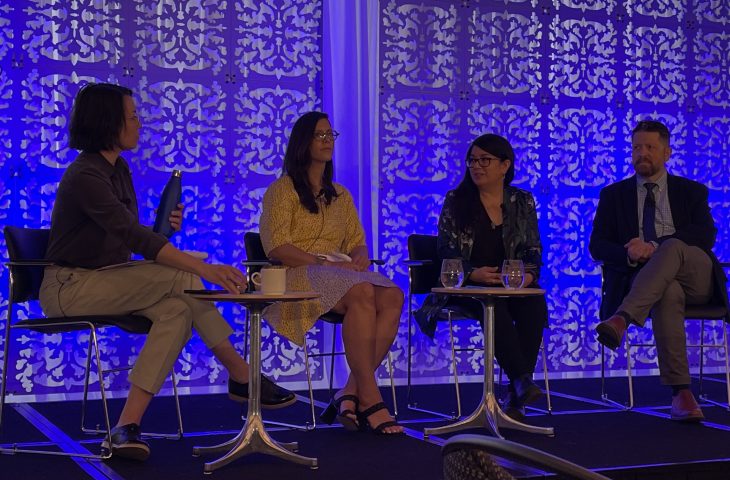
By Ken Kelley
OTTAWA – Less than a week after the House of Commons voted to send Bill C-11 to Canada’s Heritage Committee, a panel gathered at the International Institute of Communications Canada’s 2022 conference weighed the details and realities of the act.
Bill C-11, also known as the Online Streaming Act, was first introduced in February 2022. Its goals include clarifying the scope of the Broadcasting Act, which dates back to 1991, and determining how the latter should apply equitably to online streaming services.
Today’s panel comes on the heels of a Globe & Mail-Nanos Research poll, which shows 55% of Canadians support or somewhat support greater government regulation of the Internet, while 37% oppose or somewhat oppose it and 8% are unsure.
The poll also shows 67% of Canadians support or somewhat support requiring streaming services to contribute to the creation of Canadian content, 22% oppose or somewhat oppose it and 11% are unsure.
Marcia Douglas (above, second from right), vice-president, industry and business affairs with the Canadian Media Producers Association, said the association not only supports the bill, it is anxiously awaiting to dig into the details of what comes next.
“The bill does a great job at modernizing things in terms of the system,” she said. “The bill does a tremendous job at advancing conversations around diversity and inclusion and how we can do more to support Indigenous broadcasting, Canadian storytelling, and stories that are more reflective of all Canadians and that serve all audiences.”
YouTube Canada’s head of government affairs and public policy, Jeanette Patell (above, second from left), said since YouTube’s arrival in Canada, how content is created and consumed has completely transformed the media landscape.
“We’ve moved from a world where a selective group of cultural gatekeepers decided what got made and by who,” Patell said. “And today, any Canadian with a smartphone and an idea can be a creator on YouTube. What we’re seeing is an incredible diversity in content and Canadians thriving in that ecosystem. That’s the lens we apply when we think about Bill C-11.”
Patell went on to note YouTube is not opposed to the use of Bill C-11 as it relates to commercial music on the platform but said the text of the bill in its current iteration means any content on YouTube could fall under this purview, putting creator livelihoods at risk.
According to Kevin Desjardins (above, right), president of the Canadian Association of Broadcasters, the bill needs to ensure the rules laid out are fair and equitable between foreign and Canadian players.
“We can’t have one set of rules for Canadian broadcasters and another set for foreign streamers,” he said, noting a movie shot in Canada does not automatically make it Canadian content.
Patell noted Desjardins’ latter comment was the precise reason why it is so challenging to apply the C-11 framework to user-generated content.
“As soon as you apply that framework to digital-first creators, you tilt the playing field in the favour of the large, established players who have regulatory teams, lawyers and understand how to navigate the rules already,” she offered, saying it is the smaller creators looking to gain a foothold in the industry who will be inadvertently punished by Bill C-11.
“It was never designed for them, not intended for them and shouldn’t be applied to them.”
Moderator Catalina Briceño (left), professor at the Université du Québec à Montréal noted that in an earlier IIC session, CRTC CEO Ian Scott said the framework would not be applied to user-generated content, and added that a spokeswoman for Heritage Minister Pablo Rodriguez also confirmed users and creators would not be regulated.
“Platforms are in, user-generated content is out,” Briceño reiterated.
Patell countered that it had been made “very clear” the CRTC was delegated, and had the authority, to regulate user-generated content. Citing Section 4.21, she noted the bill would give latitude to the CRTC to prescribe programs to which the regulations would apply. Patell said that latitude is so broad, it could effectively encompass virtually all content published on YouTube.
“It’s asking tens of thousands of creators to bet their livelihoods on the strength of political prognostications,” she said. “When we have a government and regulator that say their intent is not to capture user-generated content, the best and most effective way to address that is to have that clearly reflected in the text of the bill.”
The above photo shows the panellists who appeared today in person. Not pictured is Monique Simard, chairwoman of the board of the Quebecor Fund, who participated in the panel virtually.



